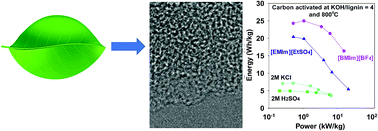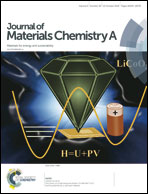Valorization of lignin waste: high electrochemical capacitance of lignin-derived carbons in aqueous and ionic liquid electrolytes†
Abstract
This report describes the utilization of waste lignin-derived activated carbons (LACs) as high-energy/high-power electrode materials for electric double layer capacitors (EDLCs). The influence of the carbon-pore structure on the capacitance of the LACs in two aqueous (H2SO4 and KCl) and two ionic liquid (1-ethyl-3-methylimidazolium ethylsulfate, [EMIm][EtSO4], and 1-butyl-3-methylimidazolium tetrafluoroborate, [BMIm][BF4]) electrolytes is evaluated. In EDLCs containing aqueous H2SO4 as the electrolyte, the LACs exhibit specific capacitances of up to 223 F g−1 and good cycling stability, with an energy density of 5.0 W h kg−1 at a power density of 200 W kg−1. EDLCs containing KCl achieved a specific capacitance of 203 F g−1, and an energy density of 7.1 W h kg−1 at a power density of 510 W kg−1. The specific capacitances of the LACs in [EMIm][EtSO4] and [BMIm][BF4] were up to 147 F g−1 and 175 F g−1, respectively. The energy density in the IL electrolytes is up to 25 W h kg−1 at a power density of 500 W kg−1 and 16.4 W h kg−1 at 15 kW kg−1. We demonstrate that the electrochemical performance of the LACs depends not only the surface area and pore size, but also on the pore-wall thickness.



 Please wait while we load your content...
Please wait while we load your content...